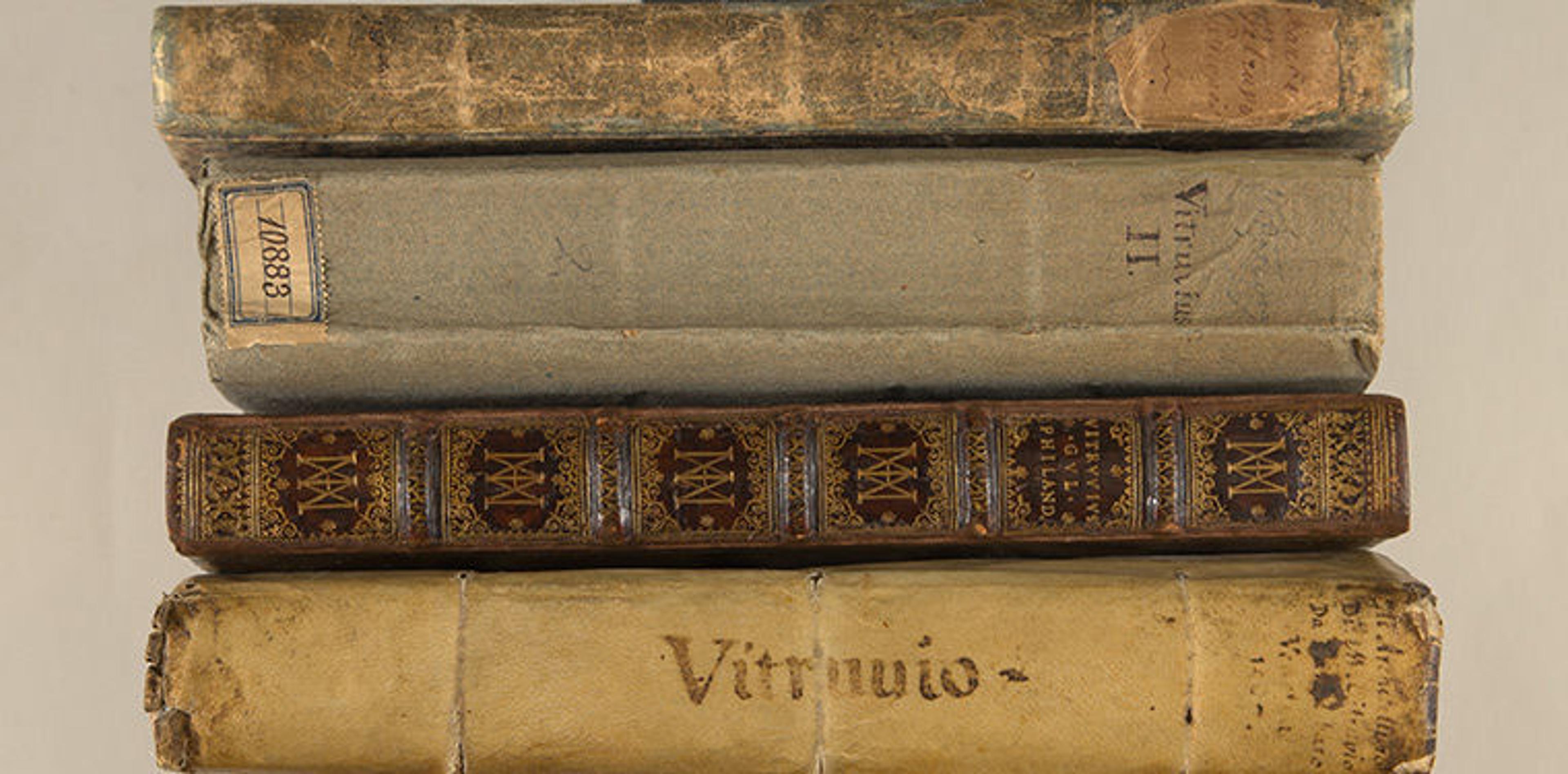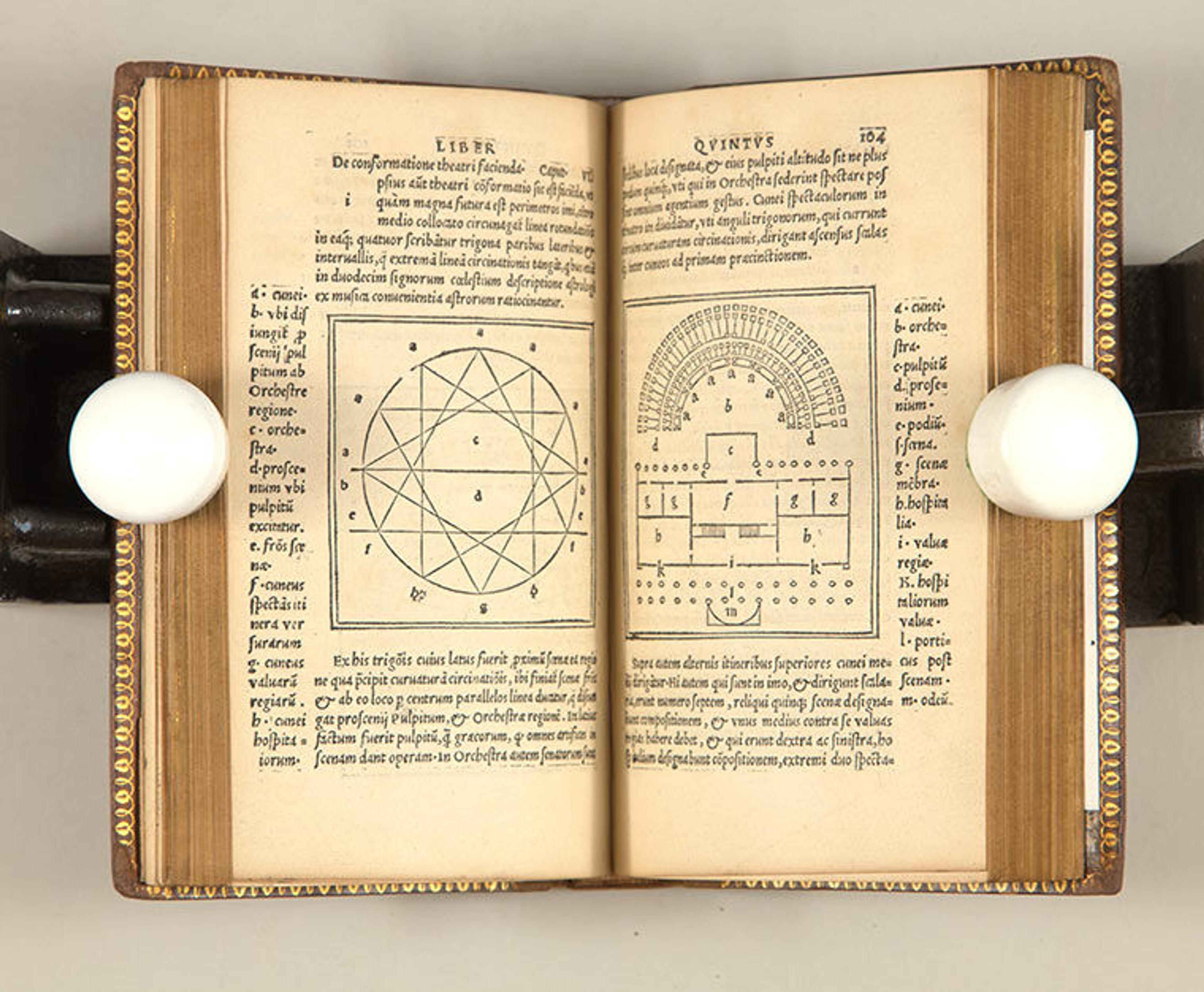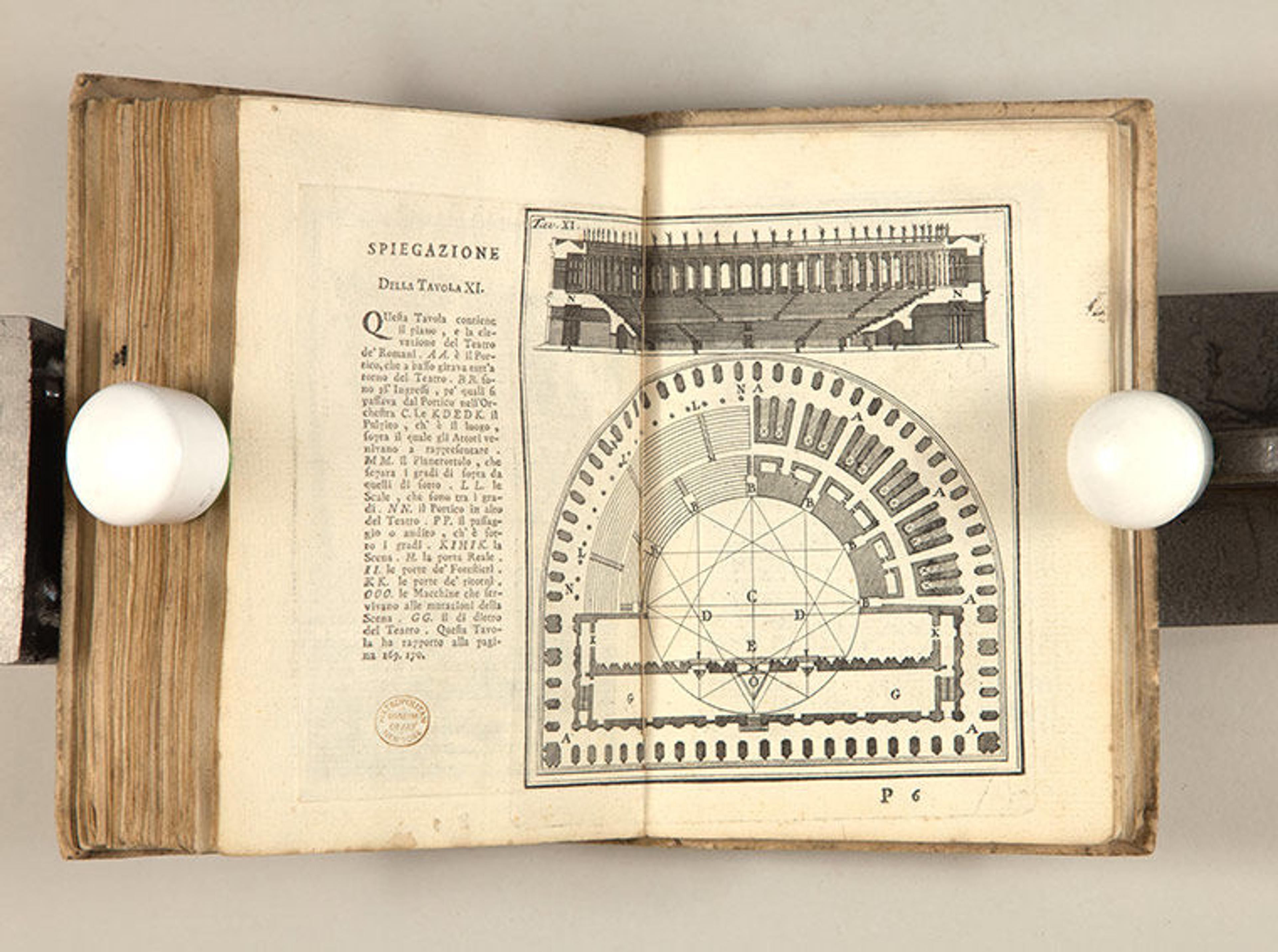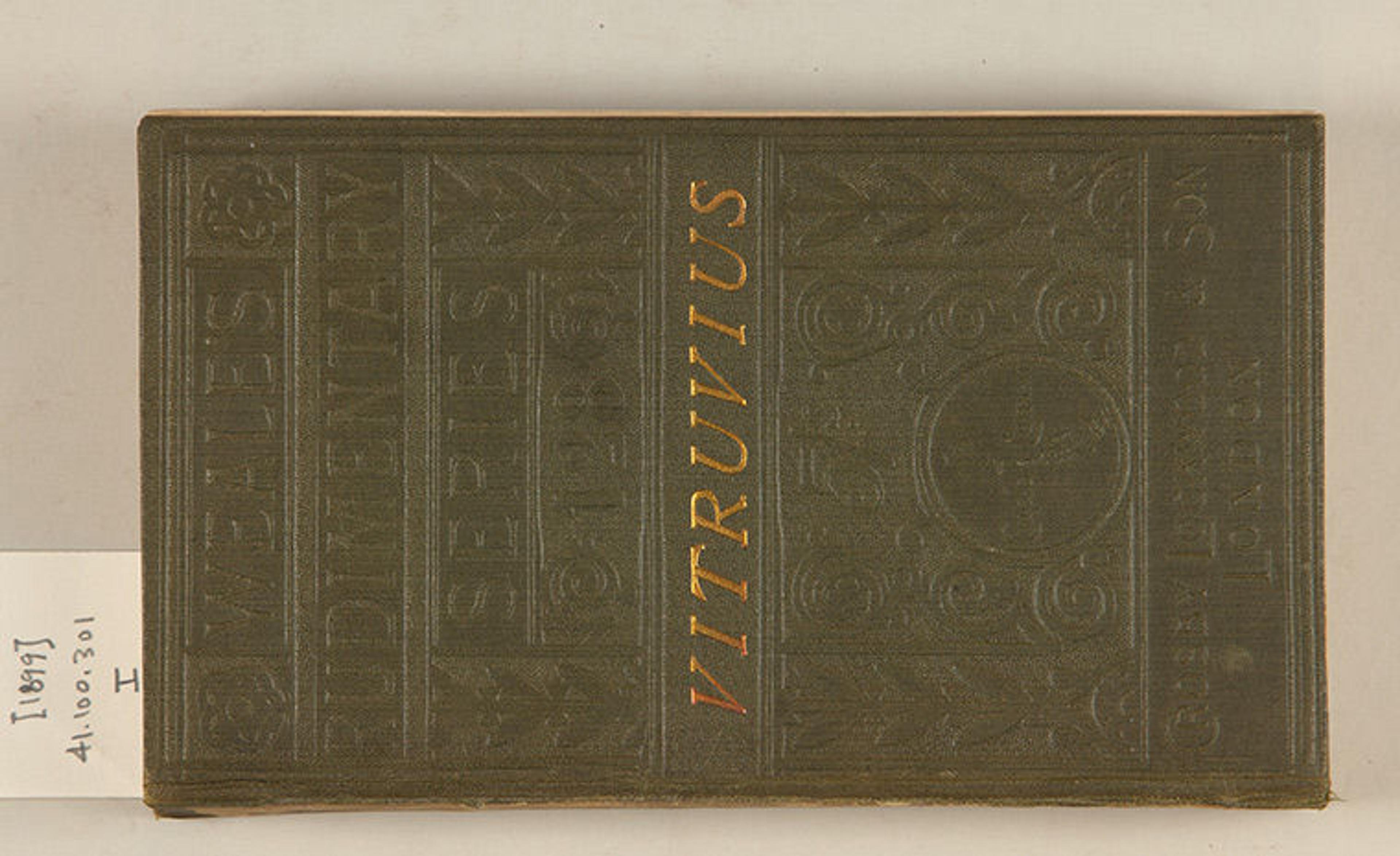Variations of Vitruvius: Four Centuries of Bookbinding and Design

Spines of four books bound in marbled paper, plain paper, leather, and vellum. All photos by the author
Over an eight-month period, I had the opportunity to conserve and rehouse ninety-five copies of De Architectura libri decem (The Ten Books of Architecture) by the Roman author, architect, and engineer Marcus Pollio Vitruvius (active late first century AD) in the collection of the Department of Drawings and Prints. These books are part of a gift of 356 publications that was donated to the department by the architect William Gedney Beatty (1869–1941). He not only searched for unique editions of the publication, but also took great pleasure in collecting multiple copies of a specific edition. Through comparison, he discovered changes and differences between them—such as varying sizes from pocket-size volumes to folios, the use of different title pages, different bindings in various grades of luxury, different language editions from Greek and Latin to local vernacular, printing mistakes, and all kinds of additions such as annotations, coloration, and collectors' marks.

Left: Philandrier, Guillame. M. Vitruvii Pollionis De architectura libri decem (. . .). Lyon: [Jean de Tournes], 1552 (41.100.504). Right: Philandrier, Guillaume. M. Vitruvii Pollionis De architectura libri decem (. . .). Lyon: [Jean de Tournes], 1552 (41.100.503)
In working on this subgroup of the Beatty collection, a conservation project funded by a grant from the New York State Library's Conservation and Preservation of Library Research Materials Program, I found that the condition of the ninety-five bindings ranged from fair to poor condition, with publications covering six countries and four centuries. The groups formed a veritable mini-catalog of binding history: the binding materials included vellum, leather, cloth, and paper; and the text blocks were created using a variety of printing techniques. Throughout this project I realized how passionate Beatty must have been to collect more than three hundred bindings on early modern Vitruvius editions. I find it compelling to see the subtle and extreme differences between each publication and between copies of the same edition, such as the two versions of Guillaume Philandrier's 1552 Vitruvius edition displayed above.
Variations in Illustration
Another fascinating dimension of the Beatty collection is the variation in interpretations of the same illustration throughout the decades and across countries, rendered by different artists and printers. I was drawn in particular to the range of design layouts for Greek and Roman theaters and found in many variants of the theater illustrations. Below are six versions of the illustration.
In this early sixteenth-century French edition, woodblock illustrations are placed directly in the text, which was bound in full leather.

M. Vitruvii De Architectura libri decem. Lyon: [Guillaume Huyon], 1523 (41.100.511)
Another slightly later Italian edition, published in 1556, includes volvelles of a theater design attached with thread. The book is bound in full vellum with a painted green spine and woodcut illustrations. Historian Dr. Edmund Thomas, an associate professor and senior lecturer in ancient visual and material culture in the Department of Classics and Ancient History at Durham University, explained the reasoning behind the spinning image to me in an email:
This is Francesco Marcolini's mechanical reconstruction of the double theater of [Gaius] Curio developed from Palladio's survey of a real Roman theater in the Veneto, which Daniele Barbaro (whose great-uncle Ermolao had been concerned with this reconstruction of Curio's theater previously) incorporated into the first (1556) edition of his commentary on Vitruvius. The two theaters were joined together by means of large bronze wheels on which the pivots turned [represented in the book by the thread attaching the volvelle to the page].
Barbaro, Daniele. I dieci libri dell’architettura di M. Vitruvio tradutti et commentati da monsignor Barbaro (. . .). Venice: [Francesco Marcolini da Forli], 1556 (41.100.356). Animated image by Seth Persons
The interactive print was discarded in the later, extended edition of the same book, likely because the mechanism was fragile. They rarely survive and if still present, volvelles are often found damaged through use. As such, in the later edition, the publisher Francesco Franceschini instead opted for a more simple two-page spread.

Barbaro, Daniele. I dieci libri dell’architettura di M. Vitruvio, tradotti et commentati da Mons. Daniel Barbaro (. . .). Venice: [Francesco de'Franceschi], 1567 (41.100.359)
The same publisher issued an edition in smaller size in 1584 and there offered the illustration of the same theater as a fold-out plate next to the related text.

Barbaro, Daniele. I dieci libri dell’architettura di M. Vitruvio, tradotti et commentati da Mons. Daniel Barbaro (. . .).Venice: [Francesco de'Franceschi], 1584 (41.100.373)
Nearly two centuries later, the German printers Lochner and Meyer opted for the same solution for their version of the theater illustration, but here the pull-out plate was bound in the back of the book. An added sheet of blank paper allows it to be folded out and remain visible while the reader consults the affiliated text.

Perrault, Claude. Des Grossen und Weltberühmten Vitruvii Architectura, in des Kurze Verfasst, durch Herrn Perrault. Würzburg: [Lochner und Meyer], 1757(41.100.314)
This solution is more elegant than the one chosen by the Venetian publisher Albrizzi a decade earlier. In his edition, bound in heavy handmade paper, the illustration is printed alongside the text, but due to its size had to be printed across the fold.

Perrault, Claude. L’Architettura Generale Di Vitruvio Ridotta in Compendio Dal. Sig. Perrault. Venice: [Giambattista Albrizzi], 1747 (41.100.236)
Variations in Binding
I also found remarkable variation in the designs and materials of the bindings, which show how styles, tastes, and economics influenced bookbinding over time and place.
The stone pattern of marbled paper is used to cover the boards on a quarter leather binding with five raised bands laced into the boards.

Cesariano, Cesare. Di Lucio Vitruvio Pollione De architectura Libri Dece. Como: [Gottardo da Ponte], 1521 (41.100.328)
Cloth publishers' bindings were introduced in the early 1800s as a lower-cost alternative to leather. This example, with the title stamped in gold, is blind-stamped in a complex pattern reminiscent of panel designs that would have been used on sixteenth-century leather bindings of Vitruvius editions.

Gwilt, Jospeh. The Architecture of M. Vitruvius Pollio in Ten Books. London: [Lockwood & Co.], 1874 (41.100.301)
The conservation treatments required by these ninety-five books varied from simple cleaning and housing to more involved repairs. Amazingly, a nineteenth-century French Vitruvius edition still retains its original printed paper publisher's wrapper. Publishers used paper wrappers as an economical way to protect texts before they were properly bound. When they were first introduced, the wrappers were plain, but publishers soon realized that it could serve as a good advertisement for the book within. The wrappers of the two-volume set suffered losses, tears, and creases over the years. To repair the wrappers, I dyed Japanese paper to match the original paper and infilled the areas of loss to the edges as well as doing other necessary paper repair, so the book can now be safely handled.

Left: Before treatment. Right: After treatment. Maufras, Charles. L'architecture de Vitruve. Paris: [Charles Pankoucke], 1847 (41.100.292.1)
A sixteenth-century French edition forms the opposite end of the spectrum in terms of its binding. Kept in its original full leather binding, it is particularly noteworthy for the gold-tooled decoration on its covers. A simple border outlines each board, and each has its center a complex design within a diamond shape. What makes this design so compelling is that it was built up by the finisher using five individual brass tools, each in a different shape. The tools were repeatedly stamped, first to create the diamond-shaped outline and then to build up the pattern inside. This binding showed some wear, and had suffered damage and losses. As part of the treatment, I reattached the boards using colored Japanese paper in order to stabilize the book so it can continue to be used by researchers for years to come.

Left: Before treatment, Right: After treatment. Philandrier, Guillaume. M. Vitruvii Pollionis De architectura libri decem (. . .).Lyon: [Jean de Tournes], 1552 (41.100.505)
This remarkable collection of architecture books can be accessed by curious museum visitors by making an appointment in the Study Room for Drawings and Prints.
The author wishes to thank Femke Speelberg, associate curator in the Department of Drawings and Prints, for supplying background information on the Beatty collection.
Sophia Kramer
Sophia Kramer is an assistant book conservator in the Thomas J. Watson Library.